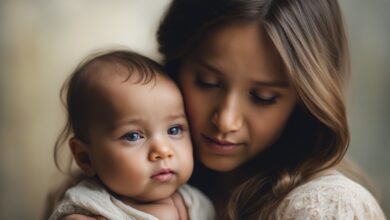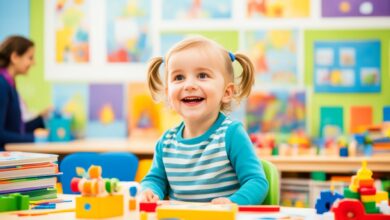
Did you know that families with three or more kids see a huge jump in sibling fights? When more kids come along, parents face a lot of emotions and conflicts. With more children, the fight for attention and different emotional needs can make things tough.
This article offers tips to help keep peace in your family. It looks at how to handle the challenges of more kids and better sibling relationships.
Key Takeaways
- More kids often lead to increased sibling rivalry and conflict.
- Understanding emotional developmental stages is crucial in managing dynamics.
- Calm leadership from parents helps in mediating disputes effectively.
- Constructive conflict resolution skills are key to maintaining peace.
- Family activities can promote bonding and reduce tensions among siblings.
The Dynamics of Family Conflict with More Kids
In families with multiple children, family dynamics change a lot. More kids mean a competitive setting where each child fights for things like toys and attention. This leads to a lot of sibling rivalry.
It’s normal for conflicts to happen as parents try to meet their kids’ different needs. Spotting patterns in how the family acts can help parents deal with issues better. For example, when siblings have different needs at the same time, stress can go up fast, making parents feel swamped.
Using good parenting strategies can make a home where kids work together and care for each other. When kids learn to share their feelings, they get better at understanding others. This cuts down on fights and makes their bond stronger.
| Factor | Impact on Family Dynamics |
|---|---|
| Resource Competition | Increased sibling rivalry, stressing parental roles |
| Diverse Needs | Challenges in addressing each child’s emotional requirement |
| Communication | Effective dialogue can mitigate conflict escalation |
| Cooperation | Encourages conflict resolution skills and emotional growth |
Knowing these things helps parents make a peaceful home. Spotting changes in family dynamics lets them act early to lessen fights over sibling rivalry. Helping kids express their feelings is key to building strong bonds between siblings.
Understanding Child Development in Sibling Relationships
Understanding child development is key to helping siblings get along. Kids go through different emotional stages that shape their relationships. It’s important for parents to know these stages to help siblings communicate and solve problems.
Emotional Stages of Development
Kids between two and four face big emotional changes. They want to be independent but still need their parents. This makes their relationships with siblings complex.
They often fight because they’re trying to find their own space. But they still need help from their parents. Knowing this can help parents understand why siblings argue.
The Importance of Autonomy
It’s important to let siblings make their own choices. This helps them feel like individuals. Parents can help by letting them make decisions together.
This not only helps solve fights but also helps them deal with others better.
| Emotional Stage | Characteristics | Impact on Sibling Interactions |
|---|---|---|
| Early Toddler (Ages 2-3) | Exploring surroundings, strong emotions | Frequent conflicts over toys, limited sharing |
| Toddler to Preschool (Ages 3-4) | Increasing independence, emotional outbursts | Need for personal space, intense emotional exchanges |
| Preschool (Ages 4-5) | Adventurous play, developing empathy | Greater cooperation, forming playgroups |
Effective Parenting Tips for Managing Conflicts
Parents play a key role in handling sibling conflicts. They need to stay calm and understanding. By leading with strength, parents can help kids solve their problems in a healthy way. They can also help kids express their feelings better.
Being a Calm Leader
When kids fight, staying calm is important. It shows them how to behave. Parents can make a stable home by using smart strategies:
- Stay neutral to teach fairness.
- Encourage kids to talk openly without judging them.
- Show how to handle emotions in a good way.
This helps kids learn how to solve problems and meet their emotional needs. Being a strong parent means helping kids become resilient and open-minded. This leads to better relationships with their siblings.
Promoting Healthy Emotional Expression
It’s crucial for kids to share their feelings when they fight. Parents should help them find the right words:
- Help kids know and say their feelings.
- Use role-playing to practice feeling and showing emotions.
- Talk about seeing things from another person’s point of view.
By teaching kids these things, parents help them express their feelings well. This creates a caring environment. It’s a great way to help siblings get along better.
| Focus Area | Parenting Tips | Impact on Siblings |
|---|---|---|
| Conflict Resolution | Stay calm and neutral | Develops resilience |
| Emotional Expression | Encourage articulation of feelings | Boosts emotional intelligence |
| Leadership | Model appropriate responses | Fosters understanding and empathy |
Strategies for Maintaining Peace Among Siblings
Siblings often face conflicts. It’s key to handle these conflicts well for peace at home. Parents can use different strategies to help siblings work together and learn how to solve problems.
Recognizing Patterns in Conflicts
First, watch how conflicts happen. Parents should see what often causes fights. Things like fighting over toys or attention are common. Knowing the root cause helps parents know how to step in.
Creating a Framework for Sharing and Turn-Taking
Setting rules for sharing can make siblings get along better. A clear plan for sharing and taking turns helps them work together. Using a schedule for toys or activities makes things fair. Praising them when they play together can change their focus from competing to working as a team.

By watching for conflict patterns and using sharing rules, families can see big changes. This approach lowers stress and helps kids learn important social skills for growing up.
| Strategy | Description | Benefits |
|---|---|---|
| Observational Analysis | Monitor conflict situations to identify triggers. | Helps in understanding underlying issues. |
| Sharing Schedules | Create clear guidelines for sharing toys and activities. | Enhances fairness and reduces arguments. |
| Positive Reinforcement | Praise siblings for cooperative behavior. | Encourages teamwork and emotional support. |
More Kids, More Social Learning Opportunities
Having multiple children means more chances for social learning. Siblings become teachers and learners to each other. They help each other deal with feelings and learn how to work together and solve problems.
When kids play together, they often have to share and make compromises. Seeing these moments as chances to learn can really help kids grow. Parents are key in teaching their kids to be empathetic and understand others.
This setup not only makes siblings closer but also helps each child become more independent. They learn to stand up for themselves while still working with others. The home is a key place for learning social skills. It prepares kids for making friends outside the family.
Fostering Positive Discipline and Cooperation
Creating a positive environment is key to getting siblings to work together better. By using smart strategies, parents can make their family more harmonious. This helps kids get along with each other.
Encouraging Praise for Positive Interactions
It’s important to praise kids when they act well together. Saying “I’m proud of how you shared your toys” can make a big difference. It shows them the value of teamwork and kindness.
When kids feel valued, they want to keep acting positively. This makes the whole family happier.
Teaching Conflict Resolution Skills
Teaching kids how to solve problems is crucial. Parents can help them talk about their feelings and find solutions. This helps kids learn how to communicate and work together better.
This approach not only makes kids stronger but also helps them understand and care for each other. These are key for a happy family life.
Role of Family Activities in Reducing Conflict
Family activities are a great way to lessen conflict among siblings. They help build strong family bonds and make cooperation easier.
Creating Bonding Experiences
Doing things together as a family is key to bonding. Activities like cooking, going on outdoor adventures, or making crafts bring everyone closer. Kids learn to enjoy being with each other, which makes their emotional ties stronger.
This leads to fewer fights and a more peaceful family life.
Encouraging Collaborative Play
Playing together helps siblings get along better. Games and team sports teach kids about each other’s strengths and weaknesses. This knowledge improves their teamwork and helps them deal with conflicts better.
Creating a culture that values working together reduces competition and supports good sibling relationships.
Conclusion
Having multiple children in a family can sometimes lead to more conflicts. Yet, it also brings chances for growth in sibling bonds and personal growth. By using good parenting methods, families can make a place that helps everyone get along better.
Knowing how kids feel at different ages helps parents help their kids deal with fights. This helps kids learn important life skills. Using strategies like seeing conflict patterns and playing together helps kids get along better.
Also, learning from each other through shared activities makes siblings closer and prepares them for life outside the family. With time and good talking, parents can help their kids be independent while keeping family ties strong.
By focusing on positive discipline and solving conflicts early, families can turn disagreements into peaceful relationships. Every time siblings interact, they learn about their feelings and how to work together. As families focus on these values, growing up becomes a time filled with understanding and love.
FAQ
What are some common reasons for sibling conflicts?
Siblings often fight over things like getting mom and dad’s attention. They also fight because they have different feelings and want to be their own person. This happens a lot during big emotional changes in their lives.
How can parents effectively manage sibling disputes?
Parents should stay calm when kids fight. They should help kids express their feelings in a healthy way. It’s also important to teach kids how to solve problems on their own.
What role does child development play in sibling relationships?
Child development is very important for sibling relationships. Kids at different ages have different emotional needs. Knowing this helps parents support and guide their kids during fights.
What strategies can parents use to promote cooperation among siblings?
Parents can make rules for sharing and taking turns. They should also notice patterns in conflicts. Encouraging kids to get along can make them work better together.
How can family activities help reduce sibling rivalry?
Doing things together as a family helps siblings bond. It lets them work as a team and see each other’s good qualities. This makes their relationship stronger and less likely to fight.
What is positive discipline, and how does it benefit siblings?
Positive discipline is about praising good behavior and teaching kids how to solve conflicts. It helps siblings get along better and communicate well, making the family more harmonious.
How can parents promote emotional intelligence in their children?
Parents can show kids how to handle emotions in a healthy way. They should teach kids to understand and share their feelings. Helping kids negotiate conflicts can also boost their emotional smarts.
What are some childcare resources that can help families with multiple children?
There are many online resources for parents with more than one child. They offer tips on parenting, childcare, and how to plan for a family. These resources help parents support their kids’ relationships with each other.




